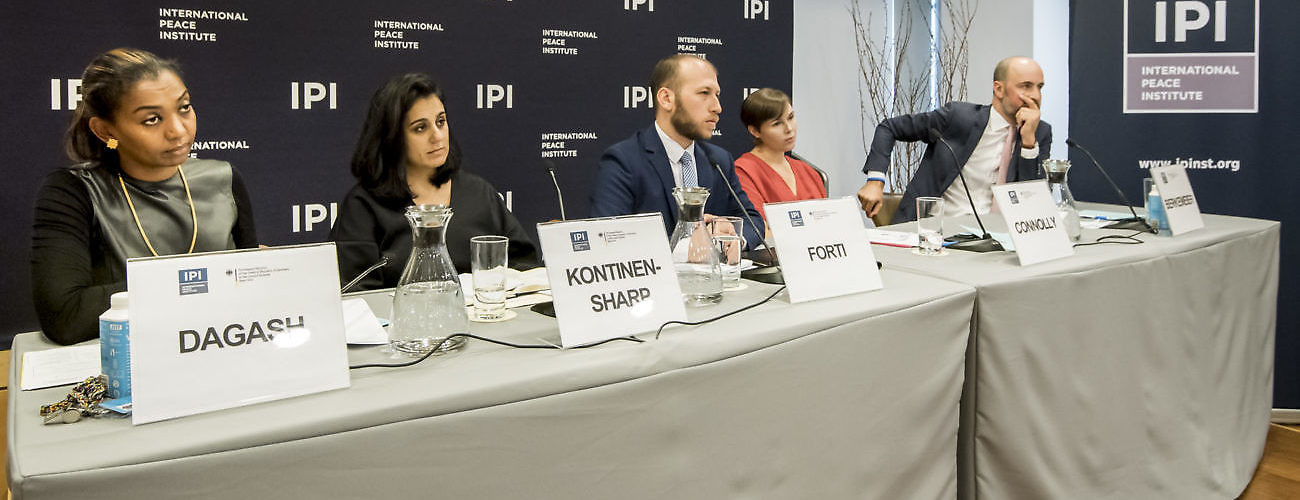There has been a 25% reduction in United Nations peacekeeping troops since 2014, and while that is “largely a story of success,” the future will be more complicated, said Jake Sherman, Director of the IPI Brian Urquhart Center for Peace Operations. Five years ago, the UN had 16 peacekeeping missions, 127,000 uniformed authorized personnel, more than 22,000 civilians, and budget of nearly eight billion dollars. Since then, he explained, peacekeeping has entered a period of consolidation.
Such peace operations transitions were the subject of a September 18th policy forum at IPI co-hosted with the Permanent Mission of Germany to the UN. Panelists discussed lessons learned from recent transitions in Liberia, Haiti, and Côte d’Ivoire. They also addressed political and operational considerations for strengthening upcoming transitions in Darfur, Guinea-Bissau, and other missions.
The next wave of peacekeeping transitions “will likely grapple with unfinished political settlements, continued protection challenges, huge geographic territories with limited state presence, and weak host-state consent to the UN’s presence,” said Mr. Sherman. He pointed to IPI’s ongoing transition project, which “aims to provide forward-looking lessons for the UN about how to better manage these complex processes” that will be applicable to the remaining 13 active missions.
IPI Policy Analyst Daniel Forti, opened the discussion by explaining how, “At their core, UN peace operations transitions are about reconfiguring how the UN engages national actors on the country’s peacebuilding, development, and security priorities.” He emphasized that “transitions don’t just begin when the UN Security Council sets a final withdrawal deadline, nor do they conclude when the last peacekeeper leaves the country. Instead, transitions are multi-year processes that require sustained political, security, and programmatic engagements. “In this light,” he noted, “transitions are one of the few processes that bring together the entire UN system, with its peace and security, development, and human rights arms all playing important roles.”
Mr. Forti shared key takeaways from the reports, which included the need for shared and long-term political strategies for transitions, as well as strategic communications between the UN and host communities. He stressed the need for early UN engagement to secure adequate financing, as well as the importance of strengthening peacekeeping partnerships and capacities for transition-related support. He also highlighted the value of field-level planning strategies to guide transition processes.
Rania Dagash, Chief of the Policy and Best Practices Service in the UN Department of Peace Operations, focused on the challenges that transitions generally face and what her department has learned through those mission departures. “Transitions are fundamentally political processes,” she said, “but we often deal with them as technical processes.” She mentioned, as well, that “human aspects of the transitions,” referring to peacekeeping staff, as well as interaction with the host countries, must not be overlooked. Another objective, she noted, was sustaining political engagement after the transition of a UN operation and the withdrawal of a large mission.
Ms. Dagash pointed to the importance of safeguarding the space for peacebuilding as UN leverage decreases during this period of waning support for multilateralism. She focused as well on the lack of resources and funding for peacebuilding activities, and how this has posed a challenge in host countries after a transition. “When the UN leaves,” she pointed out, “the money leaves with it.” This compounds the risk of relapse into conflict, which is a real threat in some of the countries. She argued, “We can design and plan our transitions better.”
Taija Kontinen-Sharp, Chief of Staff in the Office of the Assistant Secretary-General for Development Coordination, cited the “universality” of the Sustainable Development Goals as an “anchor to the broader conversation about peace and development” in the context of transitions. She asked, “How do we sustain peace in places such as Haiti where many of the issues at the heart of it are sustainability and development issues?” Confronting these issues, she said, required joint planning and a “vision of a broader trajectory for peace and development in a country.”
Ms. Kontinen-Sharp cautioned against thinking of mission drawdowns and closure as the end of the UN presence in a country. Instead, she said, “We’re not talking about a new face, but a different kind of configuration and UN support for the country.” But, she said, “we need to do joint analysis better, and that needs to be our entry point.” She mentioned Haiti as a good example of joint planning where the UN country team and peacekeeping mission “were working together from day one to see where do we want to land” and “how does the mission look in the context of the development agenda?”
She explained that the UN Development Coordination Office was now “thinking through programmatic responses in a transition context,” and discussing drawdown processes and logistics. She emphasized the need to “make sure that we have a very clear programmatic transition.” Resident Coordinators once were responsible for UN Development Program management, which occupied fifty to sixty percent of their time, said Ms. Kontinen-Sharp. So the delinking of the Resident Coordinator system from the UN Development Programme (UNDP) provided UNDP with more time to invest in development coordination and system leadership, she explained, which is a “commodity that the system didn’t have previously.”
“In my own view,” said Ms. Kontinen-Sharp, “We’ve gone a long way in terms of coming together at the UN community, across technical pillars in working on transitions.” She said she would be interested to see whether there could be more conversations around transitions in the UN Economic and Social Council to complement those taking place in the Security Council (ECOSOC).
Lesley Connolly, Global Peacebuilding Policy Advisor at the Life and Peace Institute, spoke on the case of Liberia and what could be learned from the closure, in March 2018, of the UN mission in Liberia (UNMIL), which then transitioned to a UN country team. UNMIL, she explained, was one of the most successful peace operation transitions and implementations of the secretary-general’s Peacebuilding and Sustaining Peace Framework.
UNMIL’s transition encompassed a military drawdown process that ended in June 2016, and was then followed by a civil drawdown and reconfiguration that lasted through March 2018 and marked the end of the mission. “The challenge, however, is that disproportionate amounts of attention were given to security and military transition versus the civilian transition,” Ms. Connolly said. This, she noted, “placed significant planning burdens on the mission and the UN country team to address rapidly what should be long-term processes.”
Ms. Connolly emphasized that transitions need to be aligned with external changes in a country. She determined that Liberia underwent a “Triple Transition,” in that the country was not only shifting from a UN Peacekeeping Operation to a UN country team, but that the Liberian government itself was undergoing a transition. Meanwhile, the UN development system reform was taking place, and Liberia was the first country implementing this new model. Its first post-conflict democratic transition took place following elections at the end of 2017. She said that the full implications of all this would not be felt “for a long time.”
The final recommendation she addressed was that after a transition, it is necessary to give sustained attention to the country’s new needs, in the context of the mission’s departure, adding that the Peacebuilding Commission (PBC) is one example of a valuable tool for this support.
She concluded, “Transitions are multi-year processes that require sustained political, security, and programmatic engagements from the whole UN. Focusing on long-term planning for the transition process from an early stage is vital. The transition needs to be driven by analysis on the ground, and rooted in the realities of capacities and political dynamics.”
Gunnar Berkemeier, First Secretary at the Permanent Mission of Germany to the UN, spoke on the role that Germany had played in peace operations transitions during the country’s time on the Security Council. The key lesson, he said, was that “transitions are inherently political.” He pointed out the juxtaposition that many topics and discussions in the Security Council have very long and systematic processes, but that the Council needs to be flexible, at times, to adapt to present realities. He gave the example that in the UN mission in the Democratic Republic of the Congo (MONUSCO), “the majority of the Council thought that we were in a clear drawdown situation and ready for transition, but election results were unexpected, and the UN needed to react and adapt.”
Mr. Berkemeier said that benchmarks for withdrawal, such as elections, will never give the answer of whether it is a good or bad time to withdraw. “In the end, it will be a political decision and a political discussion about whether and when” to transition. He concluded by explaining that the Peacebuilding Fund is an important tool in aiding peacekeeping transitions, but that it cannot be the only tool. Transition support requires, in addition, he said, action from the Fifth (budgetary) Committee of the UN, because, “transitions are never the time to be stingy.”
The event was moderated by Mr. Forti.








